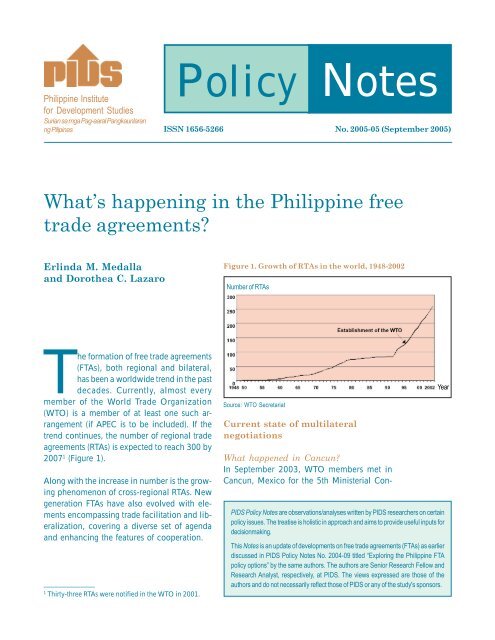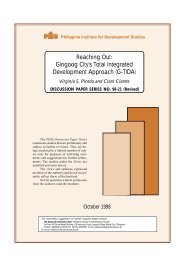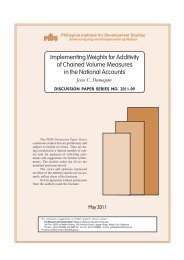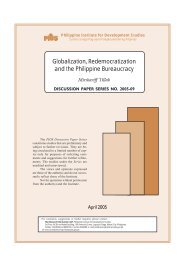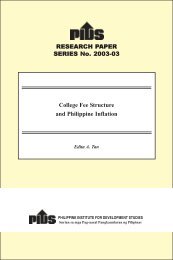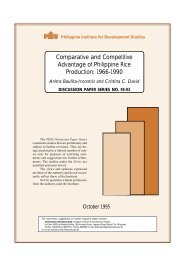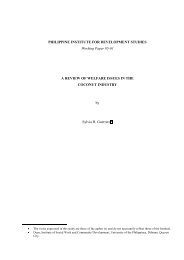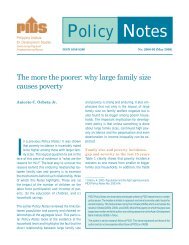What's Happening in the Philippine Free Trade Agreements?
What's Happening in the Philippine Free Trade Agreements?
What's Happening in the Philippine Free Trade Agreements?
Create successful ePaper yourself
Turn your PDF publications into a flip-book with our unique Google optimized e-Paper software.
4Americas, on <strong>the</strong> o<strong>the</strong>r hand, is a preferentialtrade agreement. Thus, its scope of activity rema<strong>in</strong>slargely limited to trade and <strong>in</strong>vestmentalthough it has been used as a forum for discuss<strong>in</strong>gand implement<strong>in</strong>g standards for laborand <strong>the</strong> environment (Choi and Caporaso2002). Efforts are currently be<strong>in</strong>g pursued toward<strong>the</strong> formation of <strong>the</strong> <strong>Free</strong> <strong>Trade</strong> Agreementof <strong>the</strong> Americas (FTAAs) which would rivalthat of <strong>the</strong> EU’s economic union. Meanwhile,although East Asia lags far beh<strong>in</strong>d <strong>in</strong>terms of <strong>in</strong>stitutionalization, <strong>the</strong> ma<strong>in</strong> focus ofRTA activity has shifted away from Europe <strong>in</strong><strong>the</strong> last two years toward Asia Pacific, specifically<strong>the</strong> East Asian region.Shift to regional/bilateral FTAapproachCountries traditionally favor<strong>in</strong>g most favorednation (MFN) liberalization are <strong>in</strong>creas<strong>in</strong>glybe<strong>in</strong>g drawn <strong>in</strong>to RTAs. They now see FTAs ascomplementary to <strong>the</strong> WTO process. Moreover,issues that usually take time or have a “deadlock”before <strong>the</strong> multilateral negotiations arebrought by <strong>the</strong>m <strong>in</strong> <strong>the</strong> RTA forum, as seenbelow <strong>in</strong> <strong>the</strong> examples of Japan and <strong>the</strong> UnitedStates.Japan. Japan has abandoned its “s<strong>in</strong>gle track”approach to multilateral WTO. Among <strong>the</strong> reasonsare: (1) its grow<strong>in</strong>g disenchantment with<strong>the</strong> GATT/WTO; 5 (2) Ch<strong>in</strong>a’s threat to replaceJapan as <strong>the</strong> primary driv<strong>in</strong>g force for economicgrowth and <strong>in</strong>tegration <strong>in</strong> <strong>the</strong> region; and (3)It was <strong>in</strong> <strong>the</strong> late 1990s when <strong>the</strong> region saw movesto <strong>in</strong>stitutionalize free trade agreements throughbilateral FTAs and o<strong>the</strong>r <strong>in</strong>itiatives. Now, <strong>the</strong>re is an<strong>in</strong>creas<strong>in</strong>g trend toward an East Asian economic<strong>in</strong>tegration. East Asian regionalism appears to becharacterized and stimulated more by dynamicdevelopments <strong>in</strong> markets ra<strong>the</strong>r than by formalpolitical <strong>in</strong>stitutions...<strong>the</strong> need for a domestic structural reform catalyst.Japan’s FTA <strong>in</strong>itiatives consist of a dual ortwo-track approach that is negotiat<strong>in</strong>g withASEAN as a whole and bilaterally with <strong>in</strong>dividualmember countries.USA. On October 26, 2002, President GeorgeBush announced United States’ trade <strong>in</strong>itiativewith <strong>the</strong> ASEAN called <strong>the</strong> Enterprise for ASEANInitiative (EAI). Under <strong>the</strong> EIA, <strong>the</strong> US and <strong>in</strong>dividualASEAN countries will jo<strong>in</strong>tly determ<strong>in</strong>eif and when <strong>the</strong>y are ready to launchfree trade agreement (FTA) negotiations. For<strong>the</strong> United States, FTA has become an importantelement of its trade policy, a strategyknown as “competitive liberalization.” Thisstrategy is designed to simultaneously push tradeliberalization forward on <strong>the</strong> bilateral, regionaland multilateral fronts. It is meant to spur tradenegotiations by liberaliz<strong>in</strong>g trade with countrieswill<strong>in</strong>g to jo<strong>in</strong> FTAs, and to pressure o<strong>the</strong>rcountries to negotiate multilaterally. 6East Asia FTA formationIt was <strong>in</strong> <strong>the</strong> late 1990s when <strong>the</strong> region sawmoves to <strong>in</strong>stitutionalize free trade agreementsthrough bilateral FTAs and o<strong>the</strong>r <strong>in</strong>itiatives.Now, <strong>the</strong>re is an <strong>in</strong>creas<strong>in</strong>g trend toward anEast Asian economic <strong>in</strong>tegration. East Asian regionalismappears to be characterized andstimulated more by dynamic developments <strong>in</strong>markets ra<strong>the</strong>r than by formal political <strong>in</strong>stitutions,i.e., <strong>the</strong> convergence of <strong>the</strong> East Asianmarket 7 is actually happen<strong>in</strong>g even prior to <strong>the</strong>formal <strong>in</strong>tegration phase (Krumm and Kharas2003). None<strong>the</strong>less, a need for a formal FTA is______________5This is due to <strong>the</strong> breakdown of <strong>the</strong> WTO m<strong>in</strong>isterial talks<strong>in</strong> Seattle <strong>in</strong> December 1999 and <strong>the</strong> dissatisfaction with<strong>the</strong> implementation of rules specifically on anti-dump<strong>in</strong>gby some WTO members.6US Congressional Research Service (2003) available atwww.crs.gov.7An example is <strong>the</strong> <strong>in</strong>ternational production shar<strong>in</strong>g schemewhich resulted <strong>in</strong> a remarkable <strong>in</strong>crease and concentrationof <strong>in</strong>traregional trade.PN 2005-05PolicyNotes
<strong>in</strong>creas<strong>in</strong>gly be<strong>in</strong>g felt ow<strong>in</strong>g to still fragmentedmarkets with<strong>in</strong> <strong>the</strong> region characterized by diversityof cultures, and economic and politicalstructures.Consequently, <strong>the</strong>re is also a plethora of proposalsfor both bilateral and regional arrangements<strong>in</strong> <strong>the</strong> region. As such, it is not unlikelythat an East Asia-wide FTA 8 would be achievedsooner or later. This is also <strong>in</strong>evitable ow<strong>in</strong>g to<strong>the</strong> grow<strong>in</strong>g sentiment that trade liberalizationwith<strong>in</strong> <strong>the</strong> ambit of <strong>the</strong> WTO and APEC hasnot been mak<strong>in</strong>g substantial progress. In addition,Ch<strong>in</strong>a’s succession to <strong>the</strong> WTO, <strong>the</strong> successful<strong>in</strong>tegration of <strong>the</strong> European regionthrough <strong>the</strong> European Community (EC); and<strong>the</strong> impend<strong>in</strong>g FTAAs, had shaped <strong>the</strong> grow<strong>in</strong>gsentiment for <strong>the</strong> need to create a “strategicalliance,” if only to enable <strong>the</strong> Asian regionto face <strong>the</strong> current global trad<strong>in</strong>g movement.______________8The concept of a broad East Asian FTA was discussed at<strong>the</strong> December 2000 ASEAN Plus Three summit to <strong>in</strong>cludeCh<strong>in</strong>a, Japan and South Korea. The framework for <strong>the</strong> EastAsia FTA f<strong>in</strong>ds its basis from <strong>the</strong> “Jo<strong>in</strong>t Statement on East AsiaCooperation” (Manila 1999). The Statement declared that<strong>the</strong> future issues of concern for ASEAN+3 would <strong>in</strong>cludeeconomic, monetary and f<strong>in</strong>ancial, social and human development,scientific and technological development, cultureand <strong>in</strong>formation, development cooperation, and politicaland security issues. S<strong>in</strong>ce <strong>the</strong>n, several m<strong>in</strong>isterial levelmeet<strong>in</strong>gs and two work<strong>in</strong>g groups have been organized. In<strong>the</strong> ASEAN+3 summit, short- term measures like <strong>the</strong> formationof <strong>the</strong> East Asia Forum and East Asia Bus<strong>in</strong>ess Counciland long-term measures like <strong>the</strong> formation of <strong>the</strong> East Asia<strong>Free</strong> <strong>Trade</strong> Area and evolution of ASEAN+3 summit to EastAsian summit were <strong>in</strong>troduced. The process of <strong>the</strong> East Asianregionalism has been progress<strong>in</strong>g along two tracks, onebe<strong>in</strong>g f<strong>in</strong>ancial cooperation and <strong>the</strong> o<strong>the</strong>r toward an Asianeconomic community (Young 2004).Developments of FTAs <strong>in</strong>volv<strong>in</strong>g<strong>the</strong> Philipp<strong>in</strong>esAs early as <strong>the</strong> 1980s and <strong>in</strong> <strong>the</strong> face of grow<strong>in</strong>gregional <strong>in</strong>tegration and global competition,<strong>the</strong> Philipp<strong>in</strong>es’ strategy had shifted froma protectionist regime to a relatively openeconomy. In <strong>the</strong> pursuit of regional cooperation,it was a party to <strong>the</strong> establishment of <strong>the</strong>Asia Pacific Economic Cooperation (APEC) <strong>in</strong>1989 as well as <strong>the</strong> creation of <strong>the</strong> ASEAN <strong>Free</strong><strong>Trade</strong> Area (AFTA) <strong>in</strong> 1992. The failure, however,of <strong>the</strong> two successive rounds <strong>in</strong> <strong>the</strong> WTOas well as <strong>the</strong> rise of Asian bilateralism hadprompted <strong>the</strong> Philipp<strong>in</strong>es to jump <strong>in</strong>to <strong>the</strong>“bandwagon” of forg<strong>in</strong>g FTAs. The Philipp<strong>in</strong>es<strong>the</strong>n started engag<strong>in</strong>g <strong>in</strong> formal FTA negotiations,both bilaterally, with Japan for an economicpartnership agreement, and <strong>in</strong>terregionally,for <strong>the</strong> establishment of <strong>the</strong> ASEAN-Ch<strong>in</strong>a, ASEAN-Japan and ASEAN-India FTAs.O<strong>the</strong>r prospective FTAs <strong>in</strong>volv<strong>in</strong>g <strong>the</strong> Philipp<strong>in</strong>esare <strong>the</strong> US-ASEAN, ASEAN-Korea and <strong>the</strong>ASEAN-Australia-New Zealand Closer EconomicRelations (aside from o<strong>the</strong>r bilateralengagements) arrangements.Ongo<strong>in</strong>g bilateral FTA negotiationsOn December 4, 2002, Japan’s Prime M<strong>in</strong>isterJunichiro Koizumi and <strong>the</strong> Philipp<strong>in</strong>es’President Gloria Macapagal-Arroyo held ameet<strong>in</strong>g <strong>in</strong> Tokyo dur<strong>in</strong>g <strong>the</strong> latter’s visit to Japanand discussed <strong>the</strong> establishment of a Japan-Philipp<strong>in</strong>esEconomic Partnership (JPEP).Based on <strong>the</strong> agreement on <strong>the</strong> basic frameworkfor negotiations <strong>in</strong> February 2004, <strong>the</strong>economic partnership agreement (EPA) concludedits 5 th round of negotiations last November.Negotiations were targeted for conclusionby <strong>the</strong> end of 2004 and implementationof <strong>the</strong> EPA is expected <strong>in</strong> 2005. The envisionedJPEPA has two ma<strong>in</strong> objectives—liberalizationand facilitation, and economic partnershipenhancement as shown <strong>in</strong> Table 1.Progress <strong>in</strong> <strong>the</strong> ASEAN economic<strong>in</strong>tegrationWith<strong>in</strong> <strong>the</strong> ASEAN, <strong>the</strong> overall improvementof <strong>the</strong> region’s <strong>in</strong>vestment environment as wellas strong regional growth and <strong>in</strong>tegration hadbrought attention to two th<strong>in</strong>gs: <strong>the</strong> realizationof an ASEAN Economic Community (by2020) and <strong>the</strong> pursuit of economic ties with5PolicyNotesPN 2005-05
6Table 1. Scope of <strong>the</strong> Japan-Philipp<strong>in</strong>es Economic PartnershipAgreement (JPEPA)Chapter Chapter Title Doma<strong>in</strong>No— Preamble —1 General provisions Liberalization and facilitation2 <strong>Trade</strong> <strong>in</strong> goods3 Rules of orig<strong>in</strong>4 Customs procedure5 Paperless trad<strong>in</strong>g6 Mutual recognition7 <strong>Trade</strong> <strong>in</strong> services8 Investment9 Movement of natural person10 Intellectual property11 Government procurement12 Competition13 F<strong>in</strong>ancial services cooperation Economic partnership14 Information and communications enhancementtechnology15 Energy16 Science and technology17 Human resource development18 <strong>Trade</strong> and <strong>in</strong>vestment promotion19 Small and medium enterprises20 Broadcast<strong>in</strong>g21 Tourism22 Dispute and avoidance settlement23 F<strong>in</strong>al provisions<strong>the</strong> ASEAN’s major trad<strong>in</strong>g partners throughFTAs (Table 2).As seen <strong>in</strong> <strong>the</strong> above, engagement <strong>in</strong> FTAs isthus becom<strong>in</strong>g a significant trade policy toolfor <strong>the</strong> Philipp<strong>in</strong>es. These FTA <strong>in</strong>itiatives basicallyhave a two-fold doma<strong>in</strong>: one is trade facilitationand liberalization, and two is <strong>the</strong> enhancementof economic relations, at least foreconomic partnership agreements. These objectivesmanifest <strong>the</strong> Philipp<strong>in</strong>es’ commitmentto greater trade liberalization <strong>in</strong> this era of glo-balization. With respect to <strong>the</strong> <strong>in</strong>tegration ofeconomies <strong>in</strong> <strong>the</strong> bilateral or regional level,<strong>the</strong>se preferential FTAs are seen more ascomplements ra<strong>the</strong>r than threats to <strong>the</strong> multilateralsystem of <strong>the</strong> WTO.ConclusionThe foremost consideration <strong>in</strong> enter<strong>in</strong>g <strong>in</strong>tobilateral or regional FTAs should be <strong>the</strong> Philipp<strong>in</strong>es’own national agenda. The country’sforeign trade policy with respect to engag<strong>in</strong>g<strong>in</strong> FTAs should be guided by <strong>the</strong> follow<strong>in</strong>gunderly<strong>in</strong>g pr<strong>in</strong>ciples and objectives of reforms:(1) global competitiveness, (2) susta<strong>in</strong>ablegrowth, (3) efficiency <strong>in</strong> allocation of resources,and (4) poverty alleviation.There is no s<strong>in</strong>gle template for an ideal FTA.However, <strong>in</strong> formulat<strong>in</strong>g such, a country (asenunciated <strong>in</strong> an earlier PIDS Policy Notes —PN No. 2004-09, September 2004) should atleast be able to have a clear objective with respectto: (a) <strong>the</strong> elements of an FTA, its substantivecontents and <strong>in</strong>stitutional framework;(b) <strong>the</strong> criteria for choos<strong>in</strong>g a partner to <strong>the</strong>FTA; and (c) <strong>the</strong> assurance that <strong>the</strong> FTA shouldbe more than a FTA per se and more of amechanism toward achiev<strong>in</strong>g a stronger purpose.At <strong>the</strong> same time, <strong>in</strong> draft<strong>in</strong>g <strong>the</strong> country’sareas for negotiation and FTA agenda, <strong>the</strong>country could benefit from <strong>the</strong> different modelsof FTAs entered <strong>in</strong>to by <strong>the</strong> prospective partners.F<strong>in</strong>ally, <strong>the</strong>re should also be an explicitadherence to follow<strong>in</strong>g consistency with <strong>the</strong>WTO.Aside from <strong>the</strong>se traditional FTA issues, attentionshould also be given to <strong>the</strong> so-called enhanc<strong>in</strong>gfeatures of new age FTAs. Aside from<strong>the</strong> fact that <strong>the</strong>y facilitate trade, <strong>the</strong>se provisionswould also serve as <strong>in</strong>stitutional safetynets for each FTA partner or member state. Theobjectives of <strong>the</strong> FTA would be better achievedPN 2005-05PolicyNotes
7Table 2. Prospective ASEAN+ FTAsFTA PartnerStatus of NegotiationCh<strong>in</strong>a – Sign<strong>in</strong>g of Agreement on Services and Dispute Settlement Mechanism <strong>in</strong> November 2004– Recognition by ASEAN 10 members of Ch<strong>in</strong>a’s “market economy” status on September 4, 2004– FTA establishment by 2010/2015 for ASEAN-6/Cambodia-Laos, Myanmar and Vietnam (CLMV)– Implementation of ASEAN-Ch<strong>in</strong>a FTA for <strong>Trade</strong> <strong>in</strong> Goods on January 1, 2005 (Early Harvest Program implementedJanuary 1, 2004 except Philipp<strong>in</strong>es)Japan – Target conclusion of FTA by April 2007 and implementation by 2012/2017 ASEAN found<strong>in</strong>g/new Members– Formal negotiation by April 2005– Realization of ASEAN-Japan Closer Economic Partnership <strong>in</strong> 2012India – 6th Meet<strong>in</strong>g on ASEAN-India <strong>Trade</strong> Negotiation Committee <strong>in</strong> September-October 2004– Implementation of Early Harvest Program on November 1, 2004 with complete tariff elim<strong>in</strong>ation by 2007/2010(ASEAN-6/CMLV)CER (Australia – ASEAN-CER Commemorative Summit <strong>in</strong> November 2004 (FTA launch)and New Zealand) – FTA negotiations to start <strong>in</strong> 2005European Union – Launch of <strong>the</strong> Trans-Regional <strong>Trade</strong> Initiative (TREATI)- A New Partnership with South East Asia <strong>in</strong> July 2003South Korea – Completion of <strong>the</strong> Jo<strong>in</strong>t Study on <strong>the</strong> feasibility of ASERAN-Korea FTA@ Negotiations to commence <strong>in</strong> 2005– Realization of FTA by 2009United States – Enterprise for ASEAN Initiative (EAI) announced on October 2002if, <strong>in</strong> <strong>the</strong> case of a develop<strong>in</strong>g country, provisionson cooperative undertak<strong>in</strong>gs, support andassistance <strong>in</strong> <strong>the</strong> areas of technology transfer,human resource development, environment,SMEs and <strong>in</strong>frastructure development are <strong>in</strong>cluded.In draft<strong>in</strong>g <strong>the</strong> Philipp<strong>in</strong>e FTA policy, considerationof <strong>the</strong> follow<strong>in</strong>g would prove to be useful:• Intra- and <strong>in</strong>tergovernmental coord<strong>in</strong>ationmechanisms for coord<strong>in</strong>ated policy decisionmak<strong>in</strong>gprocess;• Participation of private sector through bus<strong>in</strong>essadvocacy, consultation, observer status <strong>in</strong>negotiations; and• Network<strong>in</strong>g of negotiators, academe/expertsand bus<strong>in</strong>ess/<strong>in</strong>dustry sector as well ascivil society.F<strong>in</strong>ally, multilateralism should still be <strong>the</strong> ultimategoal. Preferential agreements could beentered <strong>in</strong>to, bilaterally, where benefits can bemaximized or specific concerns addressed,and regionally where <strong>the</strong> arrangement canserve as catalysts for development and mechanismfor a more orderly global trade order. In<strong>the</strong>se endeavors, consistency with <strong>the</strong> WTO<strong>in</strong> <strong>the</strong> long run should always be kept <strong>in</strong> m<strong>in</strong>d.ReferencesKrumm, K. and H. Kharas (eds). 2003. East Asia<strong>in</strong>tegrates: a trade policy agenda for sharedgrowth. The World Bank.Medalla, E. and D. Lazaro. 2003. The future of aJapan-Philipp<strong>in</strong>es economic partnership. DevelopmentResearch News (DRN) XXI, 5 (September-October).Makati City: Philipp<strong>in</strong>e Institutefor Development Studies.———. 2004. Explor<strong>in</strong>g <strong>the</strong> Philipp<strong>in</strong>e FTA policyoptions. PIDS Policy Notes No. 2004-09.Makati City: Philipp<strong>in</strong>e Institute for DevelopmentStudies.PolicyNotesPN 2005-05
8For fur<strong>the</strong>r <strong>in</strong>formation, please contactThe Research Information StaffPhilipp<strong>in</strong>e Institute for Development StudiesNEDA sa Makati Build<strong>in</strong>g, 106 Amorsolo Street, Legaspi Village, 1229 Makati CityTelephone Nos: 892-4059 and 893-5705Fax Nos: 893-9589 and 816-1091E-mail: emedalla@pidsnet.pids.gov.ph; l<strong>the</strong>a@pidsnet.pids.gov.ph;jliguton@pidsnet.pids.gov.phThe Policy Notes series is available onl<strong>in</strong>e at http://www.pids.gov.ph. Reentered assecond class mail at <strong>the</strong> Bus<strong>in</strong>ess Mail Service Office under Permit No. PS-570-04NCR. Valid until December 31, 2005.Young, J.C. and J. Caporaso. 2002. Comparativeregional <strong>in</strong>tegration. In Carlsnaes et al. Handbookof International Relations. SAGE Publication.Young, S. 2004. Varieties of regionalism <strong>in</strong> EastAsia: a critical assessment. Paper presentedat <strong>the</strong> PECC Forum Sem<strong>in</strong>ar “RTAs and <strong>the</strong>Future of Regional Integration <strong>in</strong> East Asiaand <strong>the</strong> Asia Pacific,” 16 April, Beij<strong>in</strong>g.New PublicationsRural F<strong>in</strong>ance <strong>in</strong> <strong>the</strong> Philipp<strong>in</strong>es: Issues and Policy Challengesby Gilberto M. LlantoThis book, which is co-published with <strong>the</strong> Agricultural Credit Policy Council (ACPC), providesa review of carefully selected literature and descriptions of valuable experiences that could leadto a policy research agenda on rural f<strong>in</strong>ance. Such an agenda must be drawn from a vision topromote <strong>the</strong> provision of efficient, broadly based, and susta<strong>in</strong>able f<strong>in</strong>ancial products and servicesto various rural economic agents. The agenda should aim at produc<strong>in</strong>g research studiesthat will offer recommendations to policymakers on how to remove <strong>the</strong> constra<strong>in</strong>ts on both <strong>the</strong>demand for and supply of f<strong>in</strong>ancial services and products <strong>in</strong> <strong>the</strong> rural areas.2005. 122 pages. 6” x 9”. PhP130.00. Foreign order (exclud<strong>in</strong>g postage and handl<strong>in</strong>g): US$7.00. ISBN 971-564-082-6Susta<strong>in</strong>able Tourism Challenges for <strong>the</strong> Philipp<strong>in</strong>esedited by Ramon Benedicto A. AlampayTourism holds <strong>the</strong> promise of <strong>in</strong>creased employment and <strong>in</strong>come opportunities for Filip<strong>in</strong>os,particularly <strong>in</strong> <strong>the</strong> coastal and rural areas of <strong>the</strong> country. Through tourism, <strong>the</strong> Philipp<strong>in</strong>esaspires to become a stronger player <strong>in</strong> <strong>the</strong> <strong>in</strong>tegrated travel <strong>in</strong>dustry of today. This volume, acollection of research papers funded by <strong>the</strong> Philipp<strong>in</strong>e APEC Study Center Network (PASCN),reflects <strong>the</strong> scope and complexity of susta<strong>in</strong>able tourism development. The various papers alsomirror <strong>the</strong> complexity of susta<strong>in</strong>able tourism development, and <strong>the</strong>y h<strong>in</strong>t at <strong>the</strong> multidiscipl<strong>in</strong>aryapproach that this mode of tourism needs to succeed. Each paper provides a unique academicangle on susta<strong>in</strong>ability and tourism.2005. 304 pages. 6” x 9”. PhP525.00. Foreign order (exclud<strong>in</strong>g postage and handl<strong>in</strong>g): US$28.00. ISBN 971-564-083-4PN 2005-05PolicyNotes


